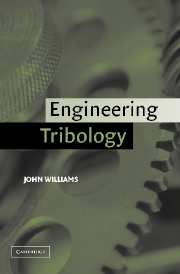Book contents
- Frontmatter
- Preface
- Contents
- Nomenclature
- 1 Introduction
- 2 Engineering surfaces
- 3 Contact between surfaces
- 4 The friction of solids
- 5 Wear and surface damage
- 6 Hydrostatic bearings
- 7 Hydrodynamic bearings
- 8 Gas bearings, non-Newtonian fluids, and elasto-hydrodynamic lubrication
- 9 Boundary lubrication and friction
- 10 Dry and marginally lubricated contacts
- 11 Rolling contacts and rolling-element bearings
- Problems
- Answers to problems
- Appendices
- Author index
- Subject index
6 - Hydrostatic bearings
Published online by Cambridge University Press: 05 June 2012
- Frontmatter
- Preface
- Contents
- Nomenclature
- 1 Introduction
- 2 Engineering surfaces
- 3 Contact between surfaces
- 4 The friction of solids
- 5 Wear and surface damage
- 6 Hydrostatic bearings
- 7 Hydrodynamic bearings
- 8 Gas bearings, non-Newtonian fluids, and elasto-hydrodynamic lubrication
- 9 Boundary lubrication and friction
- 10 Dry and marginally lubricated contacts
- 11 Rolling contacts and rolling-element bearings
- Problems
- Answers to problems
- Appendices
- Author index
- Subject index
Summary
Introduction
A hydrostatic bearing is one in which the loaded surfaces are separated by a fluid film which is forced between them by an externally generated pressure. Formation of the film, and so successful operation of the bearing, requires the supply pump to operate continuously, but it does not depend on the relative motion of the surfaces (hence the term ‘hydrostatic’). Such bearings have a great attraction to engineers; machine elements supported in this way move with incomparable smoothness and the only restriction to motion arises from the small viscous losses in the fluid. A mass supported on a hydrostatic bearing will glide silently down the slightest incline.
The essential features of a typical hydrostatic single-pad thrust bearing are shown in Fig. 6.1 (a). The bearing is supplied with fluid under pressure ps which, before entering the central pocket or recess, passes through some form of restrictor or compensator in which its pressure is dropped to some lower value pr. The fluid then passes out of the bearing through the narrow gap, shown of thickness h, between the bearing land and the opposing bearing surface or slider which is also often known as the bearing runner. The depth of the pocket is very much greater than the gap h. The restrictor is an essential feature of the bearing since it allows the pocket pressure pr to be different from the supply pressure; this difference, between pr and ps, depends on the load applied W.
- Type
- Chapter
- Information
- Engineering Tribology , pp. 200 - 231Publisher: Cambridge University PressPrint publication year: 2005

